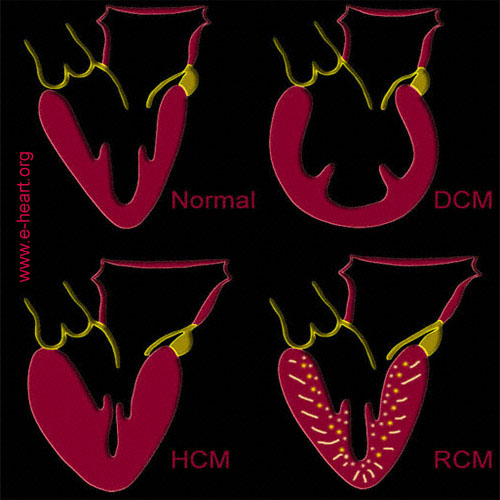What is a Cardiomyopathy?
“Cardiomyopathy” is a term that refers to the inability of the heart muscle to contract appropriately to meet the demands of the body . There are several types of cardiomyopathies defined by the World Health Organization on the basis of their pathologic or pathophysiologic features: “Dilated or cardiomyopathy” or DCM, “Hypertrophic cardiomyopathy” or HCM, “Restrictive cardiomyopathy” or RCM, “Ischemic cardiomyopathy” or ICM, and cardiomyopathies due to or associated to specific systemic diseases. One particular type of cardiomyopathy which primarily affects the right ventricle is called Arrhythmogenic Right Ventricular Dysplasia / Cardiomyopathy or ARVD / C. Recently the American Heart Association published an article describing a new framework for the classification of cardiomyopathies.
 The morphologic features of the cardiomyopathies are shows in this illustration. For comparison the normal architecture of the left ventricle is shown in the top right illustration. In DCM the left ventricle shows increase in size and volume. In HCM the ventricular walls are thick and the ventricular chamber is consequently reduced in volume. In RCM the ventricular wall may or may not be thicker. The restriction to the wall movement may be due to disease(s) that affect the endocardium such as endocardial fibroelastosis or endomyocardial fibrosis. Alternatively the restrictive condition may actually infiltrate the myocardium such as in amyloidosis. Additional examples of cardiomyopathies are here.
The morphologic features of the cardiomyopathies are shows in this illustration. For comparison the normal architecture of the left ventricle is shown in the top right illustration. In DCM the left ventricle shows increase in size and volume. In HCM the ventricular walls are thick and the ventricular chamber is consequently reduced in volume. In RCM the ventricular wall may or may not be thicker. The restriction to the wall movement may be due to disease(s) that affect the endocardium such as endocardial fibroelastosis or endomyocardial fibrosis. Alternatively the restrictive condition may actually infiltrate the myocardium such as in amyloidosis. Additional examples of cardiomyopathies are here.

